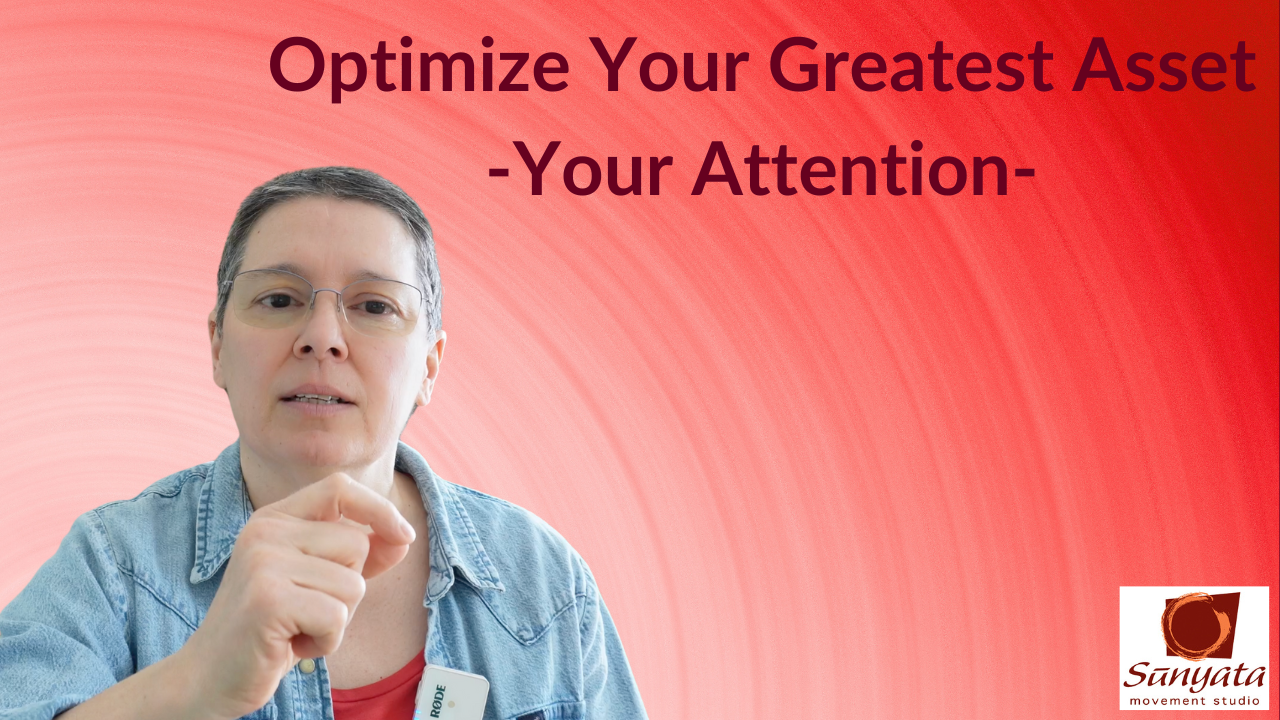
Attention is your most valuable asset.
In the Feldenkrais Method®, we learn to develop what we call “mobile attention.” Just as in movement, we don’t want to get stuck. Fluid, adaptable movement makes for a more comfortable life. In this video, Inclusive Attention: A Key to Presence, Ease & Well-Being, I define Inclusive Attention and share exercises to help you develop your skills.
Video timestamps:
00:00 Intro
00:48 Inclusive Attention (not “focused” attention)
01:19 What is Inclusive Attention?
03:08 Practice 1 of 3 – Auditory
03:49 Practice 2 of 3 – Visual
04:27 Practice 3 of 3 – Sensory
05:31 How to get the most from your practice
06:52 What’s coming next for you!
Video Transcript
What is your most valuable asset?
Arguably, it’s your attention. Intuitively, it makes sense, doesn’t it?
Your experience is largely influenced by what you choose to attend to or ignore.
So learning to attend well is key to your well-being.
In the Feldenkrais Method, we learn to develop what we call mobile attention. Just as in movement, we don’t want to get stuck. Fluid, adaptable movement makes for a more comfortable life.
And so, fluid, adaptable attentional abilities are the key to a good life.
But there is something more than just having fluid attention…
But you should know that this video is not about encouraging you to “focus” more. You see, it’s not just about what you attend to…
Or what you focus on…
But rather, how you pay attention, and how dynamically you can direct the way you pay attention, is vital.
There is a quality of being that accompanies a particular way of attending that has deep implications for our health, creativity, adaptability and well-being. This way of attending is what Moshe Feldenkrais called “inclusive attention.”
Many psychologists and neuroscientists use the lighting analogy. Focused attention is like using a spotlight (or maybe even a laser pointer). Wide open, inclusive attention is more like using a floodlight.
In today’s day and age, this inclusive way of attending seems practically lost for most, even though there is good evidence for its incredible usefulness in:
- Decreasing anxiety
- Being more present
- Learning
- Problem-solving
- Creativity
- And, well-being
Thing is, this takes practice. Neuroscientist Richard Davidson was quoted by Winifred Gallegher in her book, Rapt, as saying:
“My strong intuition is that attentional training is very much like the sports or musical kinds.”
“It’s not something you can just do for a couple of weeks or years, then enjoy lifelong benefits. To maintain an optimum level of any complex skill takes work, and like great athletes and virtuosos, great meditators continue to drill intensively.”
My experience as a Feldenkrais® practitioner over the last 25 years has shown that how we organize ourselves for movement has a profound effect on the dynamics and ease with which we can attend in different ways, as needed, given our situation, moment to moment. And… the way we attend also has a huge effect on how we move and think. It’s not a one-way street but an integrated, non-linear process.
Ok. So…
How can you develop your capacity for inclusive attention?
Well, I’m biased. Do lots of Awareness Through Movement® lessons in the Feldenkrais Method. But here are three things you can practice practically anywhere, anytime:
Here’s the first one: Try this…
Sitting or standing still, open your hearing to the 3-dimensional soundscape you find yourself in. Listen to all the sounds around you coming from all directions. Don’t focus on any particular sound. Don’t reach-out with your mind to any one sound. Rather, open yourself to the whole soundscape, allowing all the sounds from all directions come to you.
A second thing you could practice:
Let your gaze fall on anything in your visual field. Leaving your gaze there, open your attention to sense all the other lines, shapes, colours, shadows, light, textures in your visual field or peripheral vision. Again, don’t focus… Don’t “try”, just be open to all that is in your peripheral vision.
And a third thing you can practice:
Whenever you’re doing something that requires little brain power– doing dishes, folding laundry, waiting for your friend or a family member– cover yourself with your attention — cover the entire front surface of yourself (the sensations of your skin) and…
the entire back surface and…
right side and…
left side and soles of your feet and top of your head….
Again, don’t get stuck focusing on one thing or trying to bring any one thing or even everything into sharp relief. Instead, simply widen your lens to include all surfaces of yourself in your attention.
Most will find some surface much easier to connect with, while others are very vague or even inaccessible. That’s not a problem. Simply, gently intend to include all of yourself at once.
One big open field of attending.
Now, please listen to this next bit, and take it to heart:
Whichever of these explorations you engage in, let go of any ambition to be good at it.
You might notice your attention moving from one thing to another and another, like a laser pointer moving around, instead of having that one wide-open, inclusive attention. That’s fine. With practice…
Hmmm…. more specifically, with easeful practice, you’ll get better and better at organizing yourself to access more inclusive attention.
Although there are no guarantees, and you should only ever do what feels safe for you…
As you explore developing inclusive attention, you’ll likely notice a nice spontaneous shift in your breathing, a deeper presence, and a wee shift towards greater contentment.
If you like this sort of content, Subscribe to this channel.
Until next time…
Have fun!
Leave a Reply